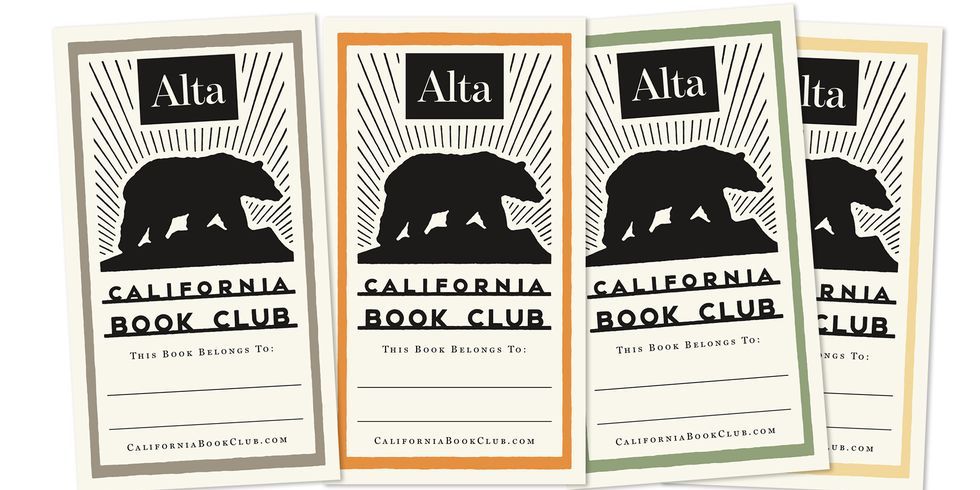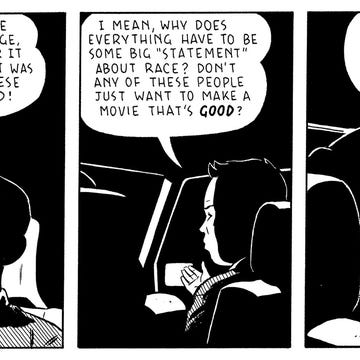While the Bay Area’s futuristic disruptions of publishing command public attention, the region should be equally known for its unusual preservation of book arts and historic letterpress printing. Arion Press, housed in an industrial building in the Presidio, is the last facility with daily operations to print books by hand from start to finish. The type-casting machine used by the press is from the 1915 Panama-Pacific International Exposition. Housed alongside Arion are a book bindery and M&H, a hot-type foundry, one of the last of its kind, that makes every piece of type, including letter spacers, that is hand-set in Arion’s artists’ books.
Poet and artist Andrew Hoyem started the press in 1965, but the equipment the press uses dates to 1920, when two brothers from the Midwest, Edwin and Robert Grabhorn, arrived in San Francisco. They launched Grabhorn Press, the bread and butter of which was printing advertisements. During fallow periods, the brothers also took on book projects, which were, initially, self-financed. Their most well-known book, however, was a printing of Leaves of Grass financed by Bennett Cerf’s Random House, for which the brothers received $16,000 for 400 copies.
The strength of their operation grew and depended, as letterpress printing does today, on apprenticeships rather than wealth and elite credentialing. Robert Grabhorn commented that, over the years, “there was always some anxious and ambitious young man who loved books and wanted to get closer to them, always bothering us. We couldn’t possibly accept all that we were offered.”
The Grabhorn brothers followed a style, pioneered by designer Bruce Rogers, known as allusive typography. With allusive typography, Grabhorn explained, the type itself alludes to “the nature of the subject or the period of the subject.” Most contemporary conversation around type emphasizes legibility, but with allusive typography, the lines and curves of a single piece of type can express a mood or feeling that ties into the semantics of the words being printed.
Designing books requires orderliness, but with letterpress, there’s whimsy involved too. In a book of Victorian type specimens, Grabhorn provided facetious headings for the specimens—one was Barnyard Elegance. The names of typefaces remain evocative even today. In the long hall that leads from the present-day foundry to the bindery, where a few female binders work, folding and gluing and sewing, are boxes full of types that have names like Greco Bold. Theodore Gioia, Arion’s director of development and programming and also a critic, noted, “There are great book titles in these.” Arion has the second-largest collection of metal typefaces in the country.
The San Francisco Renaissance was underway, but close to winding down, when Hoyem arrived in the city in 1961. He visited Auerhahn Press, where he’d placed a manuscript for a friend, and discovered it was a one-man operation in a cobblery and went to work there. In 1964, Edwin Grabhorn asked Hoyem to work for the brothers. Hoyem worked for them as a pressman part-time but stayed full-time with Auerhahn, which published books, until he thought, like many after him, “I’m not going to be a publisher anymore. This is a great way to go broke.” He decided to follow the lead of the Grabhorns, who did the bulk of their work for others.
At the end of 1965, Grabhorn Press shuttered. Hoyem and Robert Grabhorn formed a partnership. After Grabhorn died, Arion Press was born. Its first book, published in 1975, was a catalog of Hoyem’s drawings and poems that had appeared in a show at the Palace of Fine Arts.
With Arion’s artists’ books, Hoyem took the desire to wed content and type that Grabhorn Press had been known for even further. He hoped to work in an American tradition of artists’ books in which the type was so integrated with the design of the book that “you couldn’t pull these elements apart in your mind. Aesthetically, they would be bonded.” As he saw it, this was an approach different from the French tradition, in which, often, the artist’s book, or livre d’artiste, was set alongside literary work but the “two things didn’t necessarily hook up.” Rather, with Arion’s books, to this day, every element is designed to be wedded to every other element—even the type and the grain of paper express something about the text.
Hoyem stepped down in 2018, and Rolph Blythe stepped in as director of the press. A subscription series of three luxurious and unique artists’ books are printed each year to foster a special community around the written word.
For the three books in the subscription, Arion works with artists who help to reimagine a work of literature, sometimes chosen in collaboration with and with the permission of an author’s estate. Their printing is limited to 250 copies, sold first to subscribers. The 2023 subscription includes Zora Neale Hurston’s classic Their Eyes Were Watching God with artist Kenturah Davis’s brilliant work.
Davis’s art for the book features four portraits of the book’s protagonist, Janie, at pivotal moments in the book. To make these images, Davis handwrote excerpts from the book, repeatedly, until certain parts of the layered passages were so thick that they formed darker masses that reflected shadow and color within the portrait. She elaborated that these text drawings were a way of thinking about how writing, like drawing, is the process of “making a mark, assigning meaning to a mark, so that what would otherwise be abstract or arbitrary marks have meaning because we’ve learned to understand what the sequencing means.”
Davis knew of Arion before it asked her to collaborate. She’d seen the press’s edition of Poetry of Sappho, with prints by Julie Mehretu, around 2011 and was determined to one day own the book, which was expensive—she bought the book for herself on her birthday a few years later. Knowing of the press and what it did, she’d loved to dream and imagine “what my version of a book of this kind would be.” She already had a sense that it would involve a handwritten version of her text drawings.
Some Arion Press books reinvent tangible pieces of history by incorporating them into their book design. Arion’s version of the John Steinbeck and Edward F. Ricketts travelogue Sea of Cortez incorporates some of the wood from the Western Flyer, which was the boat that Steinbeck and Ricketts traveled on. Similarly, Arion’s cover of Edgar Allan Poe’s collected works, titled Poe’s Phantasia, has an inset papier-mâché brick made from bricks from Poe’s house in New York. The brick was sourced from Susan Jaffe Tane, whose collection of original and secondary Poe materials—including wood from his coffin and the watch that inspired “The Tell-Tale Heart”—is considered one of the greatest.
Some artwork is imaginative even with regard to the tools used to convey the artist’s vision. For an unforgettable edition of Mary Shelley’s Frankenstein; or The Modern Prometheus, the Los Angeles artist Tim Hawkinson said he illustrated the text using a device he’d invented out of “a plastic soda bottle, hypodermic needle, and tubing.” He thought the device looked like “something that might be found in Hollywood’s version of Frankenstein’s lab.” While he wanted the cross-hatching to provide the feeling of an etching, the art was made of line after line, each of which was “actually a drip of ink.”
Hawkinson explained that he wanted to use what he calls a drip-drawing approach, because he hoped the drawing would evoke “bodily fluids, Victor in the laboratory, and the general feeling of controlled chaos on the verge of disaster.” To enhance the chaos, he said, he “let the drips run beyond the frame and off the edge of the page.”
Beyond its limited-edition books, which are meant to endure, Arion also helps the book-arts community thrive with a gallery, an apprenticeship program, and a speaker series. More than history, the speaker series focuses on cutting-edge issues and aims to “foster relevant conversations about the place of the printed word in a vibrant society or equitable society,” Gioia explained.
Just as there are few letterpress printers, many paper mills are going under. Still, walk through this remarkable traditional operation with its books’ vibrant marriage of words and images and you’ll hold out fervent hope that it will endure, at least in this foggy pocket: long live print.•
Join us on December 21 at 5 p.m., when author Carribean Fragoza will appear in conversation with California Book Club host John Freeman and a special guest to discuss Eat the Mouth That Feeds You. Register for the Zoom conversation here.
EXCERPT
Read an excerpt from the title story of Eat the Mouth That Feeds You. —Alta
EVENT RECAP
If you missed last week’s discussion of Bad Indians: A Tribal Memoir with author Deborah A. Miranda, host John Freeman, and special guest Cutcha Risling Baldy, you can still read about it or watch the video. —Alta
NARRATIVE CAT’S CRADLE
Author Liska Jacobs (The Pink Hotel) reviews Melissa Broder’s Death Valley, which treats the High Desert as “a vehicle for grappling with existential questions.” —Alta
COLD CASE DETECTIVE
Amazon has ordered a Bosch spin-off based on Renée Ballard, the detective protagonist featured in The Dark Hours, the CBC’s April 2022 selection. —Variety
Alta’s California Book Club email newsletter is published weekly. Sign up for free and you also will receive four custom-designed bookplates.

















